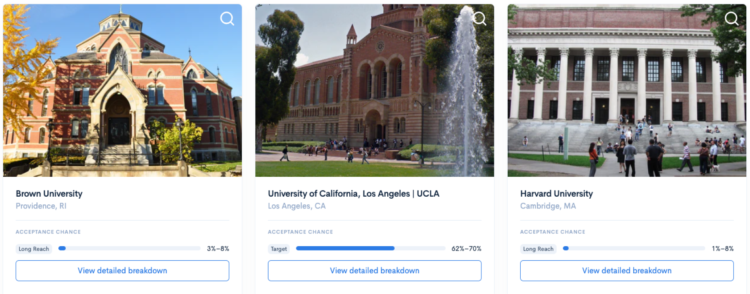How to Convert Your GPA to a 4.0 Scale (Calculator)
In a previous post, we showed you how to calculate your GPA and provided a free calculator. Now, let’s take it a step further and convert your GPA to a 4.0 scale. Use our free converter below to get your GPA converted in any scale. Then, keep reading to learn what this means.
CollegeVine's GPA Converter
Lots of colleges use a 4.0 GPA scale, but not all high schools do. Use our free converter below to find your GPA in any scale.
Where Do I Find My GPA?
You might be asking yourself, what is my GPA, anyway? Standing for grade point average, GPA is the traditional way by which high schools measure and compare their students’ academic achievement.
In most cases, students can find their high school GPA by looking at their transcript or asking their guidance counselors. However, if you need to calculate your GPA on your own, we’ll help you do so by laying out the steps later in this post. You can also use our free GPA calculator to save yourself some work.
Understanding Your GPA
As stated above, your grade point average (GPA) is a measurement of your academic performance throughout high school. However, not all schools use the same GPA scale to find this value.
There are two main kinds of GPA: weighted and unweighted. Your unweighted GPA is an average of the grades you earned without accounting for the rigor of their associated courses, while your weighted GPA accounts for honors and AP designations, granting you more credit for more challenging courses. The traditional unweighted GPA scale ranges from 0 to 4.0, while the weighted scale spans from 0 to 5.0.
Schools that use a weighted scale assign more points to honors and AP classes. For example, students who earn an A in AP Calculus would receive a 5.0 on a weighted scale and only a 4.0 on an unweighted scale. Additionally, some schools assign points for mid-level courses ranking between normal and AP classes; honors courses would fall into this category. Depending on the school, receiving an A in an honors class might be a 4.0, 4.5, or 5.0.
What is a 4.0 GPA Scale?
You know your GPA is an important factor for college admissions. But how do you know where yours falls? Most colleges use a 4.0 scale to measure your academic performance, so in order to estimate how you stack up against other admissions candidates, you’ll need to convert the average of your grades numerically. Let’s go over the basics first.
Your GPA
Your grade point average (GPA) is a measurement of your academic performance throughout high school. Your unweighted GPA is an average of the grades you earned without accounting for the rigor of their associated course, while your weighted GPA accounts for honors and AP designations, granting you more credit for more challenging courses.
The 4.0 GPA Scale
The 4.0 scale is the most commonly used GPA scale. A 4.0 represents an A or A+, with each full grade being a full point lower: 3.0=B, 2.0=C, and 1.0=D.
Pluses are an additional one-third of a point, while minuses are the subtraction of one-third of a point. For example, an A- is a 3.7, and a B+ is a 3.3. An A+, however, is the same value as an A: 4.0.
How to Convert Your GPA to a 4.0 Scale
Converting your college GPA to a 4.0 scale is not necessarily as simple as saying a 95 on a 100-point scale is a 4.0. You also need to take into account the credits each course is worth and the rigor of the courses. Follow these steps to convert your GPA using a traditional college GPA scale:
1. Compare your individual grades to a 4.0 scale.
Use this chart to determine what your grade is on a 4.0 scale:
| A+ | 97-100 | 4.0 |
| A | 93-96 | 4.0 |
| A- | 90-92 | 3.7 |
| B+ | 87-89 | 3.3 |
| B | 83-86 | 3.0 |
| B- | 80-82 | 2.7 |
| C+ | 77-79 | 2.3 |
| C | 73-76 | 2.0 |
| C- | 70-72 | 1.7 |
| D+ | 67-69 | 1.3 |
| D | 65-66 | 1.0 |
| F | Below 65 | 0.0 |
2. Weight your grades.
Add a full point to any IB or AP course, and a half point to any honors course. For example, an A in an AP course, normally a 4.0, would be a 5.0. An A in an honors course, normally a 4.0, would be a 4.5.
Here’s hypothetical student, their transcript, and what GPA values they’d receive for each grade.
| Class | Credits | Grade | Unweighted GPA | Weighted GPA |
| AP Computer Science | 4 | A | 4.0 | 5.0 |
| Honors Precalculus | 4 | A | 4.0 | 4.5 |
| Latin | 3 | B+ | 3.3 | 3.3 |
| AP Environmental Science | 4 | A- | 3.7 | 4.7 |
| AP European History | 3 | B | 3.0 | 3.0 |
| Honors English Composition | 3 | A | 4.0 | 4.5 |
| Financial Literacy | 2 | A | 4.0 | 4.0 |
3. Calculate your full GPA on a 4.0 scale.
First, multiply each weighted or unweighted grade by the number of credits associated with the course. Add these values together.
In this case, all courses are worth 1 credit except for the Financial Literacy class, which is worth .5 credits. So, we can add all the other values and halve the Financial Literacy GPA value.
Unweighted GPA values:
4(4)+4(4)+3(3.3)+4(3.7)+3(3)+3(4)+2(4) = 88.4
Weighted GPA values:
4(5)+4(4.5)+3(3.3)+4(4.7)+3(3)+3(4.5)+2(4) = 97.2
Second, divide the total by the number of total credits you earned.
Unweighted GPA:
88.4 / 23 = 3.84
Weighted GPA:
97.2 / 23 = 4.23
How to Use Your 4.0-scale GPA
Your weighted 4.0-scale GPA is the number you should report on applications. Remember that many colleges will recalculate them according to their own measures. If your high school ranks, this provides another measure for colleges to understand your academic performance.
Your GPA informs you about how you performed against other admissions candidates since this metric is universally used. You can also see how you stack up against a college’s accepted student body because most report average GPAs or the middle 50% of the freshman class’s GPAs on a 4.0 scale.
How NOT to Use Your 4.0-scale GPA
Don’t compare yourself to candidates from other high schools, because you’re dealing with different circumstances and curricula. GPA meaning varies significantly among secondary schools. In other words, a 3.5 from one school could mean something entirely different at another.
You should also avoid using your GPA to inform a definitive conclusion about whether or not you will be admitted into a college. Selective colleges perform a holistic review of your candidacy, meaning your GPA is just one part of your profile. Colleges will also take into account factors such as your extracurriculars, essay, recommendations, and other aspects of your application.
What Is a Good GPA? An Average GPA?
Colleges recognize that students hail from a wide range of backgrounds and high schools, so there’s no one answer to what constitutes a good GPA. However, most top colleges select applicants whose unweighted GPAs range from 3.5 to 4.0, giving them an average GPA grade of A- or A.
The national average GPA is slightly lower than the one sought by top colleges. The average American high schooler had an unweighted GPA of 3.38 in 2016, which translates to a B+ GPA.
In some cases, students with lower GPAs will be offered admission to selective schools. Generally, they have other desirable qualifications though, such as high test scores or top tier extracurriculars. They may also have unique circumstances, such as coming from a disadvantaged background or underrepresented minority group.
Other posts you might like:
What is Actually a Good GPA for College Admissions?
What is the Average Harvard GPA for Accepted Students?
Want to know how your GPA impacts your chances of acceptance to your dream schools? Our free Chancing Engine will not only help you predict your odds, but also let you know how you stack up against other applicants, and which aspects of your profile to improve. Sign up for your free CollegeVine account today to gain access to our Chancing Engine and get a jumpstart on your college strategy!


